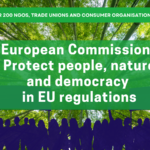
- Deal on Council negotiation position on EU climate laws finally reached, but fails to face up to urgency of the climate emergency and the need to support vulnerable people in the transition
- Ambition of Fit for 55 package continues to not be in line with 1.5°C goal
- Position still contains major flaws: Social Climate Fund shrunk, fails to curb free emission allowances to big polluters, allows fossil gas investments via the EU’s carbon market funds and too many flexibilities and loopholes in the Effort Sharing Regulation.
BRUSSELS, 29th June 2022, Environment ministers have missed their chance to champion stronger climate ambition in line with what is needed to address the climate crisis. Instead, the Council nodded through the ambition levels proposed by the European Commission one year ago and even weakened several elements of key EU climate laws, notably the Emissions Trading System (ETS), the Effort Sharing Regulation (ESR) and the LULUCF Regulation. On a positive note, ministers also agreed on the Commission’s proposal to phase out the internal combustion engine for cars and vans by 2035 and on establishing a Social Climate Fund, however with considerably less funding compared to the proposal.
Some big fights remain for the upcoming trilogue negotiations between the Parliament, the Council and the Commission, particularly on the phase out of free allowances to big polluters, on excluding all fossil investments from ETS funds as well as choosing a more ambitious reduction pathway for national climate targets in the Effort Sharing Regulation.
“Ministers have dropped the ball in ramping up the EU’s climate ambition at a time where rapid and bold action is urgently needed to face the climate emergency. This leaves a gaping hole between the EU’s measures on the ground and its commitment to the 1.5 degree goal of the Paris Agreement. This blatant lack of ambition also risks hampering the bloc’s ability to quickly wean itself off of Russian fossil fuel dependence.”
Chiara Martinelli, Director, Climate Action Network (CAN) Europe
Emissions Trading System
“Sadly it’s deja vu, Ministers have failed to boost the ambition of the world’s biggest carbon market to levels needed to address the climate crisis. On the contrary, critical elements of the Emissions Trading System have been watered down, in particular relaxing the rules for market intervention, getting rid of the conditionality for free permits and maintaining a larger bulk of free allowances to industry in the system and adding loopholes and exemptions to the ETS funds, opening the door for fossil gas investments.”
Klaus Röhrig, EU Climate and Energy Policy Coordinator, Climate Action Network (CAN) Europe
Effort Sharing Regulation (ESR)
“Ambitious national emission targets are not a luxury but a necessity – a commitment countries must make in order to avoid more severe economic, social and environmental impacts. What we’ve seen proves that EU Ministers fail to grasp the scale of the problem and the tremendous negative consequences, should the EU fail to meet its reduction targets. We need more climate ambition now, not less.”
Brigitta Bozsó, Climate Policy Expert, Climate Action Network (CAN) Europe
Land Use, Land-Use Change and Forestry (LULUCF)
“It’s a very disappointing outcome both for climate and biodiversity. Member states diluted the few good elements in the Commission proposal, the transparency and clarity were lost, and instead we got flexibilities, carry over credits and loopholes. The European Parliament will have to hold their ground in order to defend the level of ambition and good governance.”
Ulriikka Aarnio, Climate and Land Use Policy expert, Climate Action Network (CAN) Europe
— ENDS —
Notes to editors
Context:
The revisions discussed are part of the so-called Fit For 55 package which was launched in the summer of 2021 and which is meant to implement the EU’s 2030 climate target of cutting net emissions by at least 55%, compared to 1990 levels. The European Parliament has recently adopted its position on the files, equally failing to bring the overall ambition closer to levels consistent with the EU’s commitments under the Paris Agreement. In order to contribute to the goal of limiting global temperature increase to 1.5 degrees, the European Union should achieve at least 65% emission cuts by 2030.
In the run up to the Council meeting Businesses, investor groups, local and regional authorities, trade unions and civil society groups came together to demand urgent and bold action from EU Environment Ministers with a statement and letter from the coalition for Higher Ambition to Heads of States and Environment Ministers.
NGO joint call to safeguard national climate targets – letter to Environment Ministers – to call for strong Effort Sharing regulation that could provide the needed ambition and scrutiny for member states to deliver emission cuts.
Ministers have long disputed over the much needed Social Climate Fund and unfortunately decided to weaken it by reducing its size and failing to include important safeguards like excluding support for fossil fuels from the Fund.
What’s next? With both institutions, the European Parliament and the EU Council, agreeing on their main priorities on the files, they will now enter informal trilogue deliberations, together with the European Commission to come to a joint agreement on each of the legal files. This process is expected to run at least until the end of the year.
CAN Europe positions on the ETS, ESR and LULUCF.
Contact: Rachel Brabbins, Communications Coordinator: rachel.brabbins@caneurope.org // +447498 977 935



